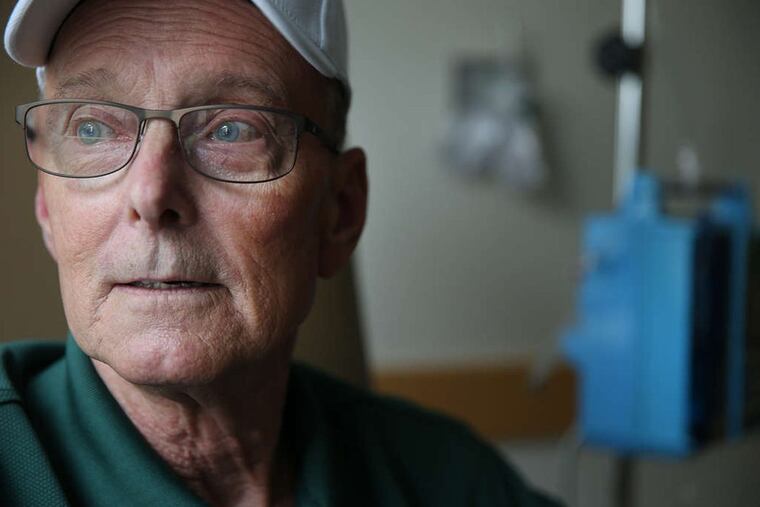Penn study points to why T-cell therapy fails in some patients
Why don't some blood cancer patients respond to T cell therapy, while others experience breathtaking remissions? University of Pennsylvania researchers may have figured out the answer.

Why do some blood cancer patients come back from death's door when their own T cells are genetically engineered to fight their disease — while other patients don't respond?
That question has bedeviled the field of T-cell immunotherapy, even as it has raced into the clinic. Novartis' Kymriah, approved last year to treat a form of pediatric leukemia, is expected to receive additional federal approval this week to treat an aggressive type of adult lymphoma. Another T-cell therapy, Gilead's Yescarta, also treats lymphoma.
Now, University of Pennsylvania researchers, who developed Kymriah with drugmaker Novartis, believe they've found an explanation for treatment failures — and it shows the still-mysterious variety and interaction of T cells, the soldier blood cells that fight infection and cancer.
Patients with stunning responses to T-cell therapy turn out to have an existing, ample supply of "memory" T cells, a subset that primes the immune system to watch for rogues. Although several types of memory T cells have been identified, the Penn-Novartis team discovered a completely new subset by analyzing the results of 41 patients who received T-cell therapy for chronic lymphocytic leukemia, or CLL.
The analysis, published Monday in Nature Medicine, found distinctive protein markers — a sort of genetic fingerprint — on this subset of memory T cells. The researchers validated this fingerprint by using it to forecast responses in eight CLL patients before they underwent T-cell therapy. All four whose cancer disappeared were correctly predicted.
In theory, this genetic fingerprint could be used to preselect patients who would respond to T-cell therapy, and screen out those who should not undergo the costly, complex process. (Kymriah, a one-dose infusion, costs $475,000, not including hospitalization costs, and takes several weeks to bioengineer from the patients' T cells.)
For now, the researchers are doing more validation work, said senior author J. Joseph Melenhorst. They are analyzing T cells stored from patients with other types of blood cancer to see whether the fingerprint can be linked to responses.
In children with a blood cancer called acute lymphoblastic leukemia, T-cell therapy has demonstrated unprecedented effectiveness. It eradicates the disease in 80 percent of cases, and about half of those remissions are lasting, based on Kymriah studies. The first child to be treated, Emily Whitehead of Philipsburg, Pa., now 12, is about to mark six years cancer free.
In contrast, only 26 percent of CLL patients have a complete remission, even though CLL launched Penn's breakthrough in T-cell research. Almost eight years ago, two of the first three CLL patients to be treated with the therapy saw their end-stage disease disappear; the third had a partial remission.
Patient number one, Bill Ludwig, 73, of Bridgeton, N.J., went from expecting to die, to expecting miracles would be standard.
"I figured if they can cure me, they can cure everyone," said the retired corrections officer.
Now, as he continues to enjoy family, travel, and hobbies, he hopes researchers can figure out the secret of his success. Ongoing check-ups show his engineered T cells are still in his body, killing B cells, the immune cells that turn malignant in CLL. Because the therapy also kills healthy B cells, he gets an infusion of an immune-boosting drug every seven weeks.
"They manipulated my immune system and activated the killer T cells. Those cells are still there, and they're still eliminating B cells," he said. "I have no side effects. It's just three or four hours that I sit in a chair" for the infusion.
>>READ MORE: The drug that controls her lupus is $8,300 a dose. Welcome to the world of biologics
How many of the newly discovered memory T cells are needed to ensure a good response? The answer is unclear, but in the validation study, researchers correctly predicted that if at least 29 percent of all T cells were memory cells, the patient's cancer would be gone three months later.
Penn researcher Joseph A. Fraietta, lead author of the new study, said the findings open the door to using genetic engineering to create synthetic memory T cells.
"We are actively working on manufacturing improvements that could enrich the therapy for these memory cells," he said. "It's a work in progress, for sure."